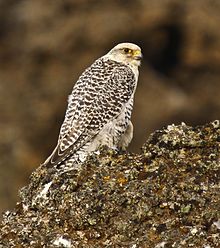
Back Falco rusticolus AN Grīpfealcen ANG سنقر Arabic سنقر ARZ Gyrfalco flaweza AVK Şunqar AZ Шоңҡар BA Крэчат BE Gerfalc'hun BR Falcó sagrat Catalan
| Gyrfalcon | |
|---|---|

| |

| |
| Scientific classification | |
| Domain: | Eukaryota |
| Kingdom: | Animalia |
| Phylum: | Chordata |
| Class: | Aves |
| Order: | Falconiformes |
| Family: | Falconidae |
| Genus: | Falco |
| Subgenus: | Hierofalco |
| Species: | F. rusticolus
|
| Binomial name | |
| Falco rusticolus Linnaeus, 1758
| |
| Synonyms | |
|
List
| |
The gyrfalcon (/ˈdʒɜːrˌfɔː(l)kən/ or /ˈdʒɜːrˌfælkən/)[3] (Falco rusticolus), also abbreviated as gyr, is a bird of prey from the genus Falco (falcons and kestrels) and the largest species of the family Falconidae.[4] A high-latitude species, the gyrfalcon breeds on the Arctic coasts and tundra, the islands of northern North America and the Eurosiberian region, where it is mainly a resident species. Some gyrfalcons disperse more widely after the breeding season or in winter, and individual vagrancy can take birds for long distances. Its plumage varies with location, with birds being coloured from all-white to dark brown. These colour variations are called morphs. Like other falcons, it shows sexual dimorphism, with the female much larger than the male.
For centuries, the gyrfalcon has been valued as a hunting bird. Typical prey includes the ptarmigan and waterfowl, which it may attack in flight; and it also hunts fish and small mammals.
- ^ BirdLife International (2021). "Falco rusticolus". IUCN Red List of Threatened Species. 2021: e.T22696500A206261845. doi:10.2305/IUCN.UK.2021-3.RLTS.T22696500A206261845.en. Retrieved 15 January 2023.
- ^ "Appendices | CITES". cites.org. Retrieved 2022-01-14.
- ^ "Definition of gyrfalcon". www.dictionary.com. Retrieved 2022-02-14.
- ^ "Gyrfalcon". Audubon Guide to North American Birds. 2014-11-13. Retrieved 2016-04-04.
